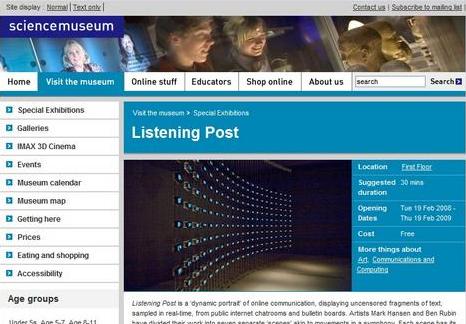Science Museum unveils internet 'Listening Post'
The museum has teamed up with the London Art Fund to showcase a unique exhibit that lets people eavesdrop on the world wide web.


Yesterday saw the unveiling of a new exhibit at London's Science Museum that allows visitors to eavesdrop on the goings on of the world wide web.
The Listening Post, which is being exhibited for two years as a result of help from a 110,000 grant from the The Art Fund, claims to offer people a "unique portrait of the internet" by trawling - in real time - through the multitude of chat rooms and bulletin boards.
The piece is the result of a collaborative effort between sound artist Ben Rubin and statistician and artist Mark Hansen who sought to answer the question: 'What would 100,000 people chatting online sound like?'
The resulting exhibit at the museum samples live text from thousands of unrestricted internet chat rooms, message boards and other public forums, displaying the results through visual and sonic means over a curved, suspended lattice comprised of 231 small electronic screens.
Computer-synthesised voices read or 'sing', the uncensored and unedited words as they surge, flicker, appear and disappear over the assembled screens. The exhibit delivers the web snippets through seven cycles, lasting around 25 minutes in total.
"We are excited to have acquired this seminal work which offers a new context for people to question and understand the impact virtual communication is having on us," said Hannah Redler, head of arts projects at the Science Museum. "With 'Listening Post' Hansen and Rubin offer us an insight into the constant chatter of this virtual 'public square' of online social spaces. It is an awe-inspiring 'portrait of chat' that reveals people's most personal thoughts and most universal concerns."
"As a snapshot of the text-based internet, 'Listening Post' may also have a finite lifespan inviting intriguing questions about the present and future of internet and web technologies, and even perhaps the nature of museum objects," said Redler.
Get the ITPro daily newsletter
Sign up today and you will receive a free copy of our Future Focus 2025 report - the leading guidance on AI, cybersecurity and other IT challenges as per 700+ senior executives
Maggie has been a journalist since 1999, starting her career as an editorial assistant on then-weekly magazine Computing, before working her way up to senior reporter level. In 2006, just weeks before ITPro was launched, Maggie joined Dennis Publishing as a reporter. Having worked her way up to editor of ITPro, she was appointed group editor of CloudPro and ITPro in April 2012. She became the editorial director and took responsibility for ChannelPro, in 2016.
Her areas of particular interest, aside from cloud, include management and C-level issues, the business value of technology, green and environmental issues and careers to name but a few.
-
 Should AI PCs be part of your next hardware refresh?
Should AI PCs be part of your next hardware refresh?AI PCs are fast becoming a business staple and a surefire way to future-proof your business
By Bobby Hellard
-
 Westcon-Comstor and Vectra AI launch brace of new channel initiatives
Westcon-Comstor and Vectra AI launch brace of new channel initiativesNews Westcon-Comstor and Vectra AI have announced the launch of two new channel growth initiatives focused on the managed security service provider (MSSP) space and AWS Marketplace.
By Daniel Todd